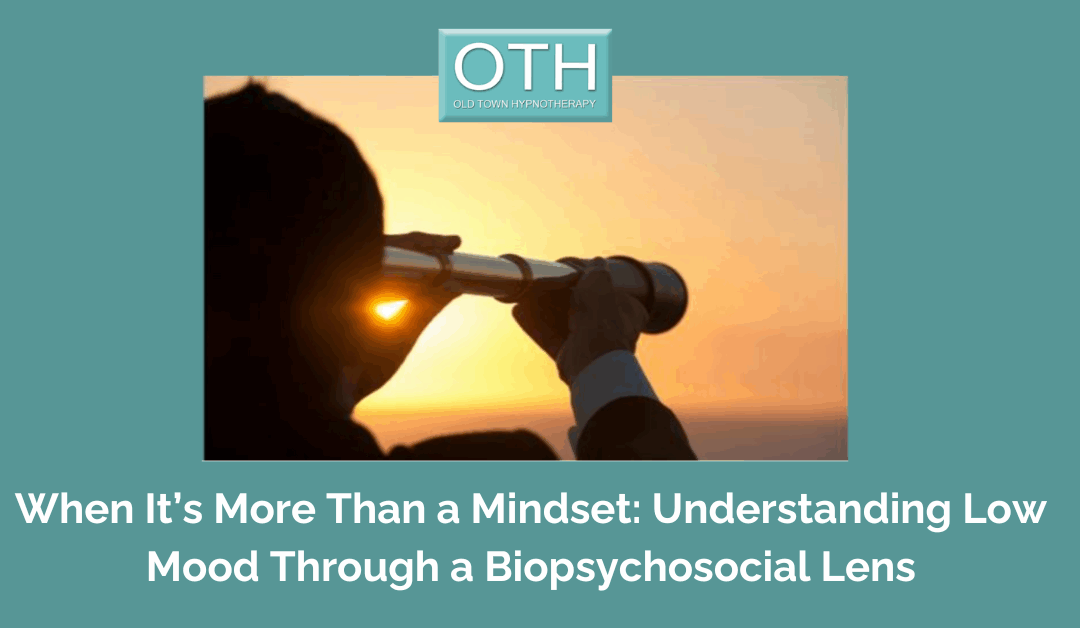When It’s More Than a Mindset: Understanding the Biopsychosocial model of low mood
If you’ve ever been told to ‘cheer up’ or ‘be positive’, you might have felt frustration, shame, or guilt. It’s a common trap—believing that if you can’t simply will yourself into happiness, you must be doing something wrong. Many clients explain that on paper, life is good, that they ‘should’ be happy, yet they feel disconnected. Low mood is more complex than mindset alone. The biopsychosocial model of low mood offers a framework that recognises the interplay between biological, psychological, and social influences.
By looking at low mood through this biopsychosocial lens, we release self-blame and understand that our feelings are not a personal failing but the outcome of multiple factors. While not all influences can be controlled, many can be gently shifted.
The Biopsychosocial Model of Low Mood
The biopsychosocial model of low mood highlights that mood is shaped by three layers: biological, psychological, and social. Each interacts with the others, meaning low mood is rarely caused by a single factor. Recognising this complexity allows us to take a more compassionate and practical approach to recovery.
The Biological Factors in Low Mood: Body and Brain
Low mood often has a biological element. This doesn’t mean you are “broken”—only that your body’s systems influence how you feel.
-
Genetics: Some people are biologically predisposed to depression or anxiety. While not destiny, it means maintaining good mood may require greater conscious effort.
-
Brain chemistry: Neurotransmitters such as serotonin, dopamine, and norepinephrine regulate mood. When imbalanced—due to stress, illness, or hormonal changes—low mood can follow. (Further reading – Happy Neurotransmitters and how to boost them)
-
Physical health: Chronic pain, thyroid issues, poor sleep, or nutritional deficiencies can all lower mood. What feels emotional may be linked to physical health.
What can help:
-
Support your body through eating well, moving daily, and prioritising sleep.
-
Consider medication or supplements where recommended—restoring balance can make other strategies more effective.
The Psychological Factors in Low Mood: Thoughts, Emotions, and Beliefs
The way we interpret life directly influences mood. Low mood can distort thinking, making neutral events feel negative or hopeless.
-
Early experiences: Childhood environments shape core beliefs. Growing up with criticism, neglect, or instability may seed beliefs like “I’m not enough.” Beliefs are formed by repetition, not fact, and confirmation bias reinforces them. With support, healthier beliefs can be nurtured.
-
Cognitive habits: Self-criticism, perfectionism, and all-or-nothing thinking can deepen sadness. Interrupting and reframing these loops helps create healthier patterns.
-
Emotional processing: Many are taught to suppress feelings. Over time, unprocessed emotions weigh heavily, feeding low mood.
What can help:
-
Learn to identify unhelpful thoughts and reframe them. Therapy provides a trained ear to spot patterns.
-
Practise self-compassion—speak to yourself with kindness, as you would to a friend.
The Social Factors in Low Mood: Relationships and Environment
Humans are social beings, and the biopsychosocial approach to low mood recognises the role of social context.
-
Life circumstances: Financial strain, housing issues, unsafe environments, or work stress take a real toll. These are not mindset problems but external realities.
-
Relationships: Supportive relationships protect against low mood; loneliness and isolation magnify it.
-
Cultural pressures: Social media comparisons, stigma, and unrealistic expectations can fuel inadequacy and shame.
What can help:
-
Strengthen connections with those who make you feel safe.
-
Seek out community groups or classes to foster belonging.
-
Take small, practical steps to ease stressors—budgeting help, workplace support, or advocacy.
Why a Biopsychosocial Lens Matters
Looking at low mood solely through “positive thinking” ignores biological and social realities. This narrow view fosters blame when people cannot “snap out of it.” The biopsychosocial model of low mood reframes this, showing that mood is shaped by many factors—biological, psychological, and social. This understanding is freeing, shifting the focus from fault to possibility.
Gentle Shifts That Support Wellbeing
Small, consistent actions create ripples of change:
-
Step outside for sunlight, send a message to a friend, or move your body for five minutes.
-
Combine supports—exercise, journaling, therapy—to strengthen resilience.
-
Give yourself permission to rest, not be okay, and ask for help.
-
Replace judgement with curiosity: ask “What might be contributing to my mood?” instead of “What’s wrong with me?”
Conclusion
Low mood is not weakness or laziness—it signals that something in your biological, psychological, or social world needs attention. Just as you wouldn’t blame yourself for catching a cold, you needn’t blame yourself for low mood.
With the biopsychosocial approach to low mood, change is gradual but possible. By addressing each layer with patience and compassion, you create conditions for your mood to lift.
If you’d like support, book a free initial consultation. We’ll explain how we can work with you to find some happy.

